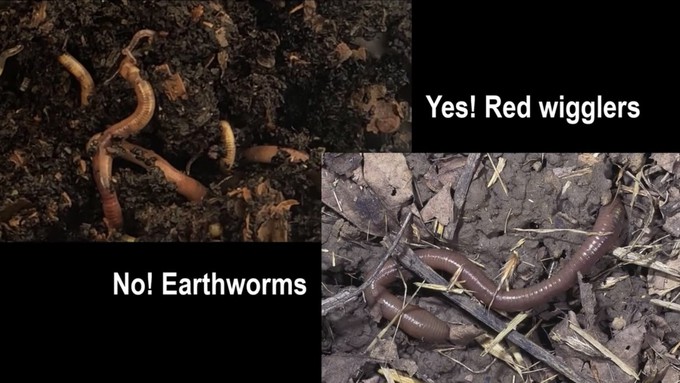
Sacramento video program an award winner

Tips on worm composting -- including the right type of worms -- are in one of the Sacramento County master gardeners' YouTube videos. Screen grab from "Making a Worm Bin"
Darkness has descended on the garden. Even on a clear day now, 4:30 p.m. is dark enough to remind gardeners to put away their tools soon and head indoors.
But the short gardening days of November and December still can be put to use: A wealth of gardening videos awaits. And preferably local ones, filmed for the Sacramento-area climate and gardening culture.
The UCCE master gardeners of Sacramento County have an active YouTube channel, with short, to-the-point videos. And the video program now is an award winner, receiving third place in this year's statewide Search for Excellence competition at the UCCE Master Gardeners Conference last month. The video submitted for the competition will debut at noon Nov. 16 on YouTube. Watch a presentation that day here on Facebook live.
In the meantime, here are suggestions for viewing this time of year:
-- Making a Worm Bin with master gardener Patty Peterson. Start a bin now and you could have rich worm castings to use in the garden next spring. A companion video shows how to harvest the castings.
-- Sharpening Hand Pruners, with master gardener Bill Black. Gardeners use their pruners all year, and it's easy for them to grow dull. This is a clear, concise instructional video that you'll come back to annually.
-- Gardening Year 'Round with Farmer Fred Hoffman. This 18-minute video was Fred's keynote talk for the 2021 all-online Harvest Day celebration. Though filmed for August viewing, it includes pertinent information for November and December on planting radishes, carrots and kale. He also discusses raised beds and cold frames for protecting cool-season vegetables, and advocates cover crops for gardens that are not being planted in winter. "At least feed your soil," indeed.
The statewide Master Gardener Program also has plenty of videos, available here. Happy viewing!
Comments
0 comments have been posted.Sacramento Digs Gardening to your inbox.
Sites We Like
Garden Checklist for week of May 12
Get your gardening chores and irrigation done early in the day before temperatures rise.
* Plant, plant, plant! It’s prime planting season in the Sacramento area. Time to set out those tomato transplants along with peppers and eggplants. Pinch off any flowers on new transplants to make them concentrate on establishing roots instead of setting premature fruit.
* Direct-seed melons, cucumbers, summer squash, corn, radishes, pumpkins and annual herbs such as basil.
* Harvest cabbage, lettuce, peas and green onions. This heat will cause leafy greens and onions to flower; pick them before they bolt.
* In the flower garden, direct-seed sunflowers, cosmos, salvia, zinnias, marigolds, celosia and asters.
* Plant dahlia tubers. Other perennials to set out include verbena, coreopsis, coneflower and astilbe.
* Transplant petunias, marigolds and perennial flowers such as astilbe, columbine, coneflowers, coreopsis, dahlias, rudbeckia and verbena.
* Keep an eye out for slugs, snails, earwigs and aphids that want to dine on tender new growth.
* Feed summer bloomers with a balanced fertilizer.
* For continued bloom, cut off spent flowers on roses as well as other flowering plants.
* Got fruit trees? If you haven't already done so, thin orchard fruit such as apples, peaches, pears, pluots and plums before they grow too heavy, breaking branches or even splitting the tree. Leave the largest fruit on the branch, culling the smaller ones, and allow for 5 to 6 inches (or a hand's worth) between each fruit.
* Thin grape bunches, again leaving about 6 inches between them. For the remaining bunches, prune off the "tail" end, about the bottom third of the bunch, so that the plant's energy is concentrated in the fruit closest to the branch.
* As spring-flowering shrubs finish blooming, give them a little pruning to shape them, removing old and dead wood. Lightly trim azaleas, fuchsias and marguerites for bushier plants.
* Add mulch to the garden to help keep that precious water from evaporating. Mulch also cuts down on weeds. But don’t let it mound around the stems or trunks of trees or shrubs. Leave about a 6-inch to 1-foot circle to avoid crown rot or other problems.